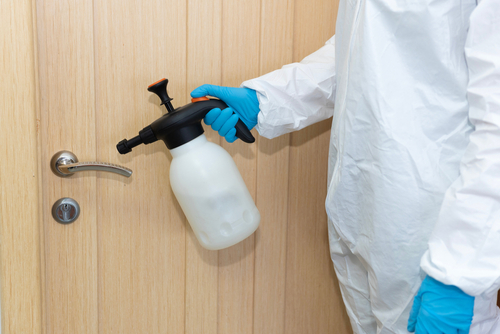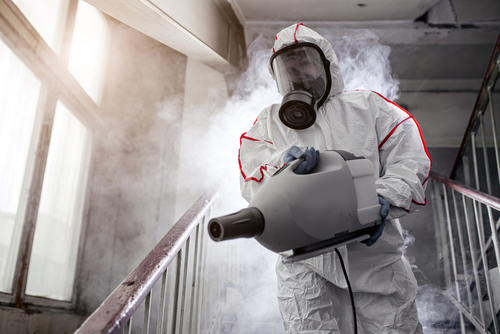
Restaurant Disinfection: Ensuring Safe Dining Experiences
August 29, 2023
Disinfection for Events: Keeping Gatherings Safe
October 3, 2023Disinfection Best Practices: Guidelines for Different Environments

Disinfection Best Practices Guidelines for Different Environments
Disinfection Best Practices: Guidelines for Different Environments. Maintaining a clean and safe environment is crucial for promoting health and preventing the spread of illnesses.
Effective disinfection is pivotal in achieving these goals by eliminating harmful microorganisms.
This article delves into the significance of tailored disinfection practices for various settings, highlighting the science behind disinfection and exploring best practices to ensure optimal hygiene.
Read on – Disinfection Best Practices: Guidelines for Different Environments:
The Importance of Effective Disinfection
Effective disinfection is a cornerstone of public health, especially when people gather and interact.
By targeting and eliminating harmful microorganisms, disinfection helps mitigate the risk of illness transmission and promotes overall well-being.
Significance of Tailored Disinfection Practices
Different environments require customized disinfection approaches to address specific challenges and high-risk areas.
Tailored disinfection practices take into account the unique characteristics of each setting and maximize the effectiveness of hygiene efforts.
Differentiating Between Cleaning, Sanitization, and Disinfection

Cleaning, sanitization, and disinfection are distinct processes that serve different purposes in maintaining a clean environment.
Cleaning involves removing visible dirt and debris, while sanitization reduces the number of microorganisms on surfaces. Disinfection goes a step further by killing or inactivating a wide range of pathogens.
Disinfection acts as a critical barrier against illness transmission by targeting pathogens on surfaces people frequently encounter.
Modes of Microbial Transmission
Microorganisms can spread through direct contact, airborne particles, and contaminated surfaces.
High-touch surfaces, such as doorknobs, elevator buttons, and shared equipment, can serve as reservoirs for pathogens, contributing to the spread of illnesses.
Disinfection in Healthcare Settings
In healthcare settings, maintaining rigorous disinfection protocols is paramount to prevent the transmission of infections.
Hospitals and clinics must adhere to strict disinfection practices to safeguard patients, healthcare workers, and visitors.
Proper disinfection reduces the risk of healthcare-associated infections, protecting vulnerable individuals from preventable illnesses.
Choosing the Right Disinfectants
Selecting appropriate disinfectants involves considering factors such as the spectrum of pathogens they target, contact time, and compatibility with surfaces.
Compatibility with materials, environmental impact, and regulatory compliance are important considerations when choosing disinfectants.
Disinfection in Public Spaces

High-Touch Surfaces
Public spaces, including transportation hubs and recreational areas, require targeted disinfection of high-touch surfaces to reduce the risk of pathogen transmission.
High-Traffic Areas in Public Settings
Identifying high-traffic areas helps prioritize disinfection efforts and allocate resources effectively.
Targeted Disinfection for Maximum Impact
Focusing on frequently touched surfaces, such as handrails, touchscreens, and seating, can significantly reduce the potential for illness spread.
Hygiene in Restrooms
Restrooms in public spaces demand comprehensive disinfection approaches to ensure cleanliness and prevent cross-contamination.
Regular disinfection of toilet seats, faucets, and door handles helps create a hygienic environment for all users.
Adequate supplies of soap, hand sanitizers, and paper towels, along with regular cleaning and disinfection, promote restroom hygiene.
Disinfection in Educational Institutions
Educational institutions play a vital role in promoting the health and well-being of students. Disinfection practices in schools reduce the risk of illness transmission among students and staff.
Disinfecting classrooms, shared materials, and high-touch surfaces supports a healthy learning environment.
Classroom Disinfection Strategies
Incorporating routine disinfection procedures into daily classroom activities maintains a clean and safe student space.
Engaging Students in Hygiene Practices
Educating students about hygiene practices, such as handwashing and proper cough etiquette, reinforces the importance of disease prevention.
Disinfection in Residential Spaces

Disinfection in residential spaces is essential for protecting family members from illness transmission.
The Importance of Disinfection in Household Environments
Home disinfection helps reduce the risk of germs entering the living space and promotes a healthy family environment.
Targeting high-touch areas in homes, such as doorknobs, light switches, and remote controls, minimizes the risk of cross-contamination.
Kitchen and Bathroom Hygiene
Kitchen and bathroom areas require special attention due to the nature of activities and potential for microbial growth.
Specific Areas in Homes Requiring Enhanced Disinfection
Bathroom surfaces, kitchen counters, and frequently used electronic devices should be regularly disinfected.
Tips for Keeping Kitchens and Bathrooms Clean
Using disinfectants approved for food contact surfaces in the kitchen and maintaining bathroom cleanliness are essential practices.
Disinfection in the Food Service Industry
Disinfection in the food service industry is integral to preventing the spread of foodborne illnesses.
Maintaining clean and sanitized surfaces and equipment is crucial for safeguarding customers and staff.
Regular disinfection of dining areas, menus, and kitchen equipment reduces the risk of cross-contamination.
Proper Dishwashing and Utensil Disinfection
Ensuring utensils, glassware, and dishware are properly sanitized prevents the spread of pathogens through contaminated items.
Utilizing high-temperature dishwashing equipment and approved sanitizing agents ensures the safety of utensils and kitchenware.
Adhering to Food Safety Regulations
Compliance with food safety regulations, including temperature control and hand hygiene, is crucial for maintaining a hygienic food service environment.
Disinfection in Travel and Transportation

Disinfection in travel settings, such as airports, trains, and buses, safeguards passengers and employees.
Regular disinfection of touchpoints, seating areas, and ticketing counters reduces the risk of illness transmission.
Focusing on high-touch areas like handrails, door handles, and luggage carts minimizes the potential for pathogen transmission.
Disinfection of Vehicles
Disinfection practices extend to personal and shared vehicles, ensuring safe travel for drivers and passengers.
Strategies for Disinfecting Personal and Shared Vehicles
Cleaning and disinfecting surfaces within vehicles, such as steering wheels, seat belts, and touchscreens, promotes a healthy driving environment.
Minimizing the Risk of Pathogen Transmission
By adopting disinfection practices, travel and transportation providers contribute to minimizing the risk of illness spread.
Green Disinfection Practices
Environmentally-Friendly Disinfection Solutions
Balancing effective disinfection with environmental responsibility involves selecting eco-friendly disinfectants.
Choosing Eco-Friendly Disinfectants and Methods
Eco-friendly disinfectants and practices contribute to sustainability and minimize environmental impact.
Balancing Efficacy with Environmental Impact
Efforts to reduce environmental impact should not compromise the effectiveness of disinfection measures.
Reducing Chemical Exposure
Minimizing the use of harsh chemicals and exploring natural alternatives supports both human health and the environment.
Minimizing Harmful Chemical Residues in Disinfected Environments
Choosing disinfectants with low chemical residues significantly reduces the potential for harmful exposure.
Exploring Natural Alternatives for Disinfection
Substances like vinegar, hydrogen peroxide, and essential oils can serve as effective and natural disinfectants.
Personal Protective Equipment (PPE) and Safety Measures

Personal protective equipment (PPE), such as masks and gloves, enhances personal safety during disinfection procedures.
Proper selection and usage of PPE ensure optimal protection against exposure to pathogens.
Adhering to safety protocols while handling disinfectants and cleaning chemicals prevents accidents and exposure.
Proper Ventilation
Proper ventilation enhances indoor air quality and complements disinfection efforts. Regularly ventilating indoor spaces helps reduce the concentration of airborne contaminants.
Regular Monitoring and Evaluation
Establishing Disinfection Protocols
Developing clear disinfection protocols ensures consistency and standardization in hygiene practices.
Tailoring disinfection plans to the unique needs of each environment enhances their effectiveness.
Incorporating Scheduled Disinfection Routine
Regularly scheduled disinfection routines ensure continuous protection against illness transmission.
Assessing Disinfection Effectiveness
Implementing monitoring systems allows for the assessment of disinfection efficacy and the identification of areas that require improvement.
Ensuring Consistent Disinfection Performance
By consistently adhering to established protocols, organizations can maintain a high standard of disinfection performance.
Collaboration with Professionals
In some cases, outsourcing disinfection services to professionals with expertise and specialized equipment is a strategic choice.
Complex environments or situations requiring specialized disinfection methods can benefit from professional expertise.
Professional disinfection services offer trained personnel and advanced equipment for thorough and effective disinfection.
Training and Education
Providing training and education empowers individuals to carry out disinfection procedures correctly.
Consistent training ensures that all personnel follow the same disinfection protocols, promoting standardized hygiene practices.
Disinfection Best Practices: Guidelines for Different Environments – Conclusion

Tailored disinfection practices are paramount for promoting health and safety from healthcare facilities to public spaces.
By understanding the science of disinfection, recognizing modes of pathogen transmission, and adhering to best practices in various settings, organizations and individuals can contribute to disease prevention and well-being.
Customized disinfection approaches that address the unique challenges of each environment serve as a cornerstone for maintaining cleanliness, protecting individuals, and elevating hygiene standards.
Are you seeking professional and reliable disinfection services in Singapore? Contact us today!



